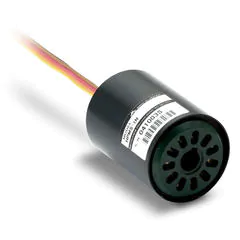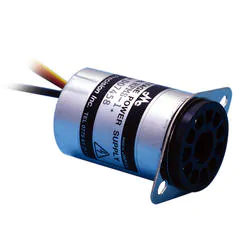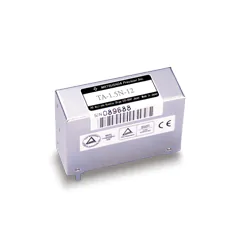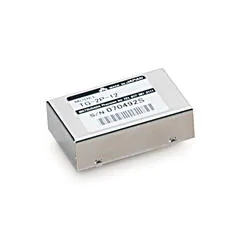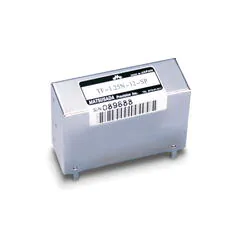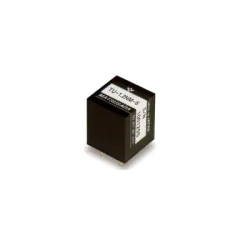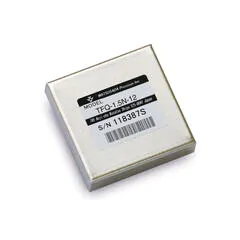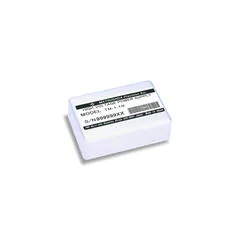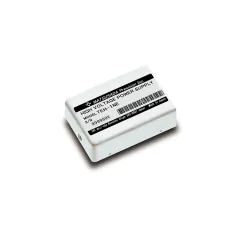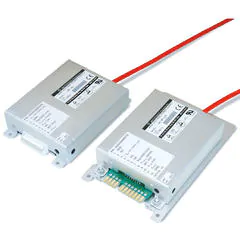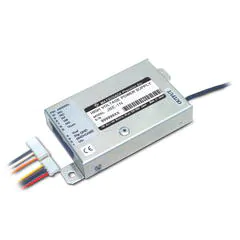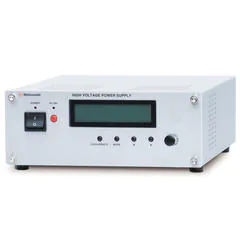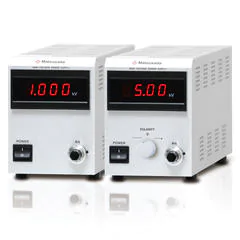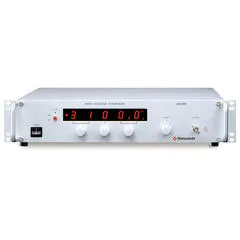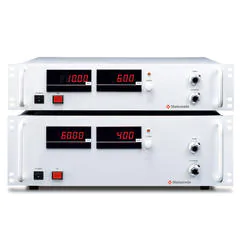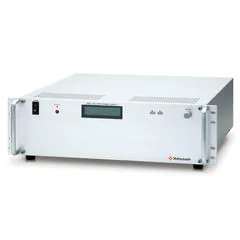What is a Photomultiplier tube (PMT)?
Photomultiplier tubes (PMTs) are among the most sensitive of all light sensors and are used to detect faint light. Tubes without a multiplication function are called phototubes (PT). The structure of a photomultiplier tube is as follows: First, light (photons) enters through an incident window and strikes a photocathode (cathode), generating photoelectrons. The photoelectrons are attracted by the high voltage applied to the cathode, electron multiplier (dynode), and anode. The photoelectrons are then accelerated and multiplied as they travel through the vacuum state. Most photomultiplier tubes have 9 to 12 dynodes and amplify to the 5th to 8th power of 10, and finally output as a current. Photomultiplier tubes are characterized by their ability to achieve extremely high current amplification rates. There are two types of photomultiplier tubes: head-on type with a photosensitive area at the tip and side-on type with a photosensitive area at the side. There are numerous types of photocathodes with different photosensitive surface sizes and wavelength sensitivities.
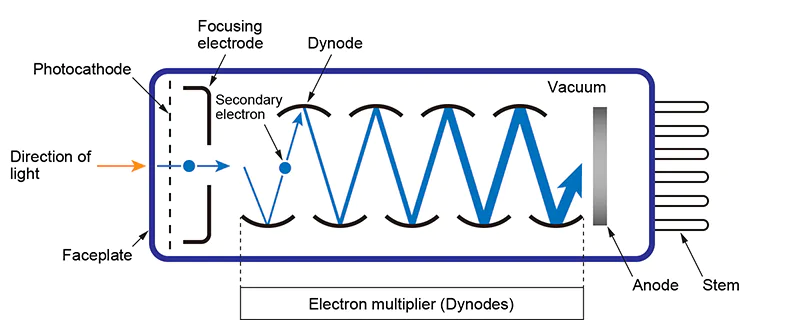
Photomultiplier tube applications
Photomultiplier tubes are used as secondary electron detectors in scanning electron microscopes (SEM). Secondary electrons generated from the sample are converted to light by the detector's scintillator and acquired as a signal by the PMT. The amount of secondary electrons becomes the amount of current, which is the intensity of the image. PMT is also used in Nox and Sox meters, which measure gas concentrations by irradiating sulfur oxides and nitrogen oxides with ultraviolet light and capturing the faint light emitted by the oxides in their excited states. In blood tests, PMT is used for fluorescence analysis, which analyzes the weak luminescence generated by reagent reactions. Kamiokande, which detects neutrinos, has become very famous, having won the Nobel Prize. If a scintillator, a material that converts radiation into light, is placed in front of the photomultiplier tube, it can be used for radiation detection and is called a survey meter. Radiation detection devices using photomultiplier tubes are used in gamma-ray detectors, gate monitors, and monitoring posts. In the past, they were used in CT scanners, but recently semiconductor sensors have been used.
High voltage power supply for photomultiplier tubes
The photomultiplier tube is characterized by its ability to achieve an extremely high current amplification ratio, but this also means that "electrical noise and voltage blurring that occurs when voltage is applied are multiplied in the same way. Even if photoelectrons are multiplied, if they are buried in noise that is also multiplied, detection becomes difficult and meaningless.
Most photomultiplier tubes operate at voltages ranging from 500 V to 2000 V. This also means that even the slightest fluctuation in the applied voltage is multiplied from the 5th power of 10 to the 8th power of 10 in the photomultiplier tube and appears as output. Therefore, in order to accurately detect weak light, a "low-noise" and "highly stable" high-voltage power supply that can fully demonstrate the true value of the photomultiplier tube is essential, in addition to the performance of the photomultiplier tube itself.
Matsusada Precision recommends power supplies for photomultiplier tubes
Matsusada Precision offers a diverse lineup of more than 1000 models of high-voltage power supplies. In particular, we have thoroughly brushed up "low noise" and "high stability" and perfected the "high voltage power supply dedicated for photomultiplier tubes" as the optimum high voltage power supply for photomultiplier tubes.
There are various types of high-voltage power supplies for photomultiplier tubes, including bench-top types, types that are built into equipment, ultra-compact types for mounting on printed circuit boards, and models that combine a high-voltage power supply, bleeder circuit, and socket in a single unit. Customers can choose from these extensive models for the power supply best suited to their requirements.
As an example, we introduce the integrated type of high-voltage power supply, bleeder circuit, and socket.
We offer a variety of high-voltage power supplies for photomultiplier tubes.
PMT Socket power supply
Since it is an integrated type, you can use it simply by inserting a compatible PMT.
Socket assembly type with high voltage power supply and voltage divider circuit for driving photomultiplier tubes.
The highly stable and low-noise operation of the photomultiplier tube is achieved by simply plugging in an appropriate photomultiplier tube and supplying a voltage of ±15 to ±24 Vdc.
PCB mounte type (on-board)
Often used when photomultiplier tubes are used as detectors in analyzers and inspection instruments.
Since the power supply is to be built into the equipment, the design of heat dissipation, as well as the temperature coefficient of the power supply, is an important factor in the selection process. Some models of Matsusada Precision have achieved very good temperature coefficients of 20 ppm/°C typical.
Chassis mount type (module)
Often used when photomultiplier tubes are used as detectors in analyzers and inspection instruments.
Since the power supply is to be built into the equipment, the design of heat dissipation, as well as the temperature coefficient of the power supply, is an important factor in the selection process. Some models of Matsusada Precision have achieved very good temperature coefficients of 20 ppm/°C typical.
Benchtop type/Rackmount type
Amazingly high performance is achieved, including a model that achieves ultra-low ripple of only 5mv (2.5ppm, 2kV output type)!
Remote functions and various interfaces (some optional) further expand the range of usage.
Photomultiplier tube (PMT) application examples
- Two-photon excitation microscopy
-
Two-photon excitation microscopy is a type of laser microscopy.
- ATP analysis (ATP test)
-
ATP analysis and the ATP test are measurements of bacterial and cellular abundance.
This is used to assess cleanliness in food manufacturing plants, kitchens, and medical facilities. ATP is adenosine triphosphate, a substance found in the cells of all living organisms. You can determine the number of bacteria and cells by measuring the amount of ATP. ATP is reacted with the enzyme and the amount of ATP is measured from its luminescence. Photomultiplier tubes are used to measure this luminescence.
Read more
- CT scanner
-
A CT scanner is a computed tomography scanner that uses X-rays to visualize the interior of an object in three dimensions (3D). Photomultiplier tubes were used to measure radiation in medical helical CTs. Modern CT scanners are called multi-slice CT and use semiconductor 64- or 128-row detectors.
- Nitrogen Oxides (NOx) Analyzers
-
NOx is a generic term for nitrogen oxides. Nitrogen oxides are NO (nitric oxide), NO2 (nitrogen dioxide), N2O (nitrous oxide), and N2O3 (dinitrogen trioxide).
NOx meters and NOx analyzers are available in two types of measurement methods: chemiluminescence and absorption spectrophotometry. Nitrogen oxides cause photochemical smog, so their concentration is measured with a NOx analyzer.
Read more
- Sulfur Oxide (SOx) Analyzer
-
SOx is a generic term for sulfur oxides. Sulfur oxides are SO (sulfur monoxide), SO2 (sulfur dioxide), and SO3 (sulfur trioxide). It is one of the indicators in exhaust gas analysis.
- Auger electron spectroscopy (AES)
-
Auger Electron Spectroscopy is also called AES. AES is a method of examining the composition of the material surface
by irradiating the sample with an electron beam and spectroscopically analyzing the generated Auger electrons.
- Gamma detector
-
A gamma detector measures the gamma radiation emitted from radioisotopes and radioactive materials.
There are ionization chamber-type instruments, GM tube-type instruments, scintillation-type instruments, semiconductor-type instruments, etc. A high-purity germanium detector and a NaI scintillation survey meter can measure gamma radiation's spectrum (energy distribution).
Read more
- Fluorescence Spectrophotometer
-
A fluorescence photometer is a type of spectrophotometer that measures the fluorescence emitted from a sample by irradiating it with light. Photomultiplier tubes are used as light detectors.
- Radiation portal monitor
-
Radiation portal monitors are devices installed to monitor the entry and exit of radioactive materials into and out of facilities and cargo at the border. Photomultiplier tubes are used as detectors to detect radioactive materials.
- Survey meter
-
A survey meter is an instrument for measuring radiation. Survey meters are portable instruments used to measure radiation leakage, radioactive contamination, and environmental radiation.
- Sulfur Analyzer
-
A sulfur meter is an instrument that measures the concentration of sulfur. X-ray fluorescence sulfur analyzers to measure sulfur in oil, which causes acid rain, and sulfur analyzers in chrome plating solution are available as sulfur meters.
- Particle Counter
-
A particle counter is a measuring instrument that measures particles in clean air, such as in a clean room. The cleanliness is measured by counting the quantity of each particle size.
- Neutrino
-
Neutrinos are a type of subatomic particle.
It can pass through any material, but it emits light when it reacts with a very small amount of water nuclei. Photomultiplier tubes are used to measure these neutrinos in Super-Kamiokande.
Read more
- Pinhole inspection
-
The pinhole inspection is used to detect small invisible holes or pinholes. There are several methods of pinhole inspection. Photomultiplier tubes are used in inspection machines that shine light on an object and detect light leaking from the pinhole.
- Flow cytometer (flow cytometry)
-
A flow cytometer is a device that arranges cells in a row and irradiates them with a laser beam for observation and measurement. Photomultiplier tubes measure the scattered light and fluorescence of laser light irradiated on cells.
- Monitoring Post (Environmental Radiation Monitoring)
-
A monitoring post is a facility set up to measure environmental radiation.
- Real Time PCR
-
Real-time PCR is a device that simultaneously performs the process of replication and amplification of DNA and detection. A photomultiplier tube is used for this detection part.
- Confocal microscopy
-
Laser microscopes irradiate a laser beam onto a sample and measure the reflected light to produce an image. A photomultiplier tube is used to measure this reflected light.
- Blood test
-
Blood and urine tests are part of biochemical analyses. The test is performed by a colorimetric analysis method. A reagent that reacts to a specific component is added to the blood, and its color is used to measure its concentration. A photomultiplier tube is used to measure this colorimetric measurement.
- Atomic absorption spectrometry (AAS)
-
AAS stands for Atomic Absorption Spectrometry. Photomultiplier tubes are used as detectors in this analyzer.
- UV-Visible Spectrophotometer (UV-Vis)
-
UV-VIS is an "UltraViolet-Visible Spectrophotometer".
Light from ultraviolet to visible wavelengths is irradiated to the sample in sequence, and the absorbance and transmittance of the light are measured. Photodiodes and photomultiplier tubes are used as light detectors.
Read more
- Dust Monitor
-
Dust monitors and dust meters are instruments that measure air particles that are dirtier than the atmosphere, such as exhaust gases and hail smoke. There are various measurement methods, but photomultiplier tubes are used as detectors for laser-based methods.
- Secondary electron detector
-
A secondary electron detector is a type of detector used in a Scanning Electron Microscope (SEM).
It is used to detect secondary electrons emitted from the surface of a sample due to electron beam irradiation. A collector electrode is provided at the tip of the detector to efficiently collect secondary electrons. In addition, since photomultiplier tubes cannot measure and receive electrons as they are, a scintillator is provided at the tip of the photomultiplier tube.
Read more
- Spectroscopy
-
Spectrometry is an analytical method that shines light on a sample and analyzes the light emitted or absorbed to identify its components.
UV-Visible Spectrophotometer (UV-VIS)" is a typical spectral analysis device. Photomultiplier tubes and photodiodes are used to measure transmitted and reflected light.
Read more
- Radiation Monitoring
-
Radiation monitors are devices that monitor radiation in the atmosphere.
Environmental radiation detectors are built into the monitoring posts. Photomultiplier tubes are used in radiation detectors.
- Radiation Thickness Gauge
-
Radiation thickness meters use a photomultiplier tube to measure the object.
It isn't easy to physically measure thin sheets of material. Therefore, radiation is irradiated and the transmitted radiation is measured with a photomultiplier tube and converted to thickness.
Read more
- Antigen-Antibody Immunoassay
- Atomic absorption spectrometry (AAS)
- ATP Analyzer
- Auger electron spectroscopy (AES)
- Blood test
- Calorimeter
- Chemiluminescence immunoassay
- Cherenkov detector
- Computed radiography (CR)
- Confocal laser scanning microscope (CLSM)
- Confocal microscopy
- CT scanner
- Environmental Radiation Monitoring
- Flow cytometry
- Fluorescence correlation spectroscopy
- Fluorescence immunoassay
- Fluorescence lifetime measurement
- Fluorescence spectrophotometer
- Gamma camera
- Gamma detector
- Gas chromatography (GC)
- In Vivo imaging
- Lidar
- Liquid Chromatography (LC)
- Neutrino
- Nitrogen Oxides (NOx) Analyzers
- Optical Emission Spectroscopy
- Particle Counter
- Photon counting
- Photostimulated luminescence
- Pinhole inspection
- Positron Emission Tomography (PET)
- PET/CT scan
- Radiation Area Monitor
- Radiation Monitoring
- Radiation portal Monitor
- Radiation Thickness Gauge
- Radioactive dust monitor
- Raman spectroscopy
- Real Time PCR
- Scanning Electron Microscope (SEM)
- Secondary electron detector
- Semiconductor wafer inspection
- Spectrofluorometer
- Spectroscopy
- Submersible Level Transmitter
- Sulfur Analyzer
- Sulfur Oxide (SOx) Analyzer
- Survey meter
- Time-Of-Flight (TOF) counter
- Two-photon excitation microscopy
- UV-Visible spectrophotometry (UV-Vis Spectrophotometer)
- X-ray astronomy
- X-ray thickness gauge
Photomultiplier Tube Terminology
- PMT
-
PMT is an abbreviation for Photomultiplier Tube.
- Dynode
-
A dynode is the electron multiplier of a photomultiplier tube. A typical photomultiplier tube has about 10 dynodes.
- Anode
-
The anode is the electrode that reads out the current amplified by the dynode (electron multiplier) of the photomultiplier tube.
- Socket
-
A socket is a round connector that plugs a photomultiplier tube for an electrical connection.
- Socket Power Supply
-
A socket power supply assembles a photomultiplier tube plug socket and a high-voltage power supply. Matsusada Precision provides PMT socket power supplies that are socket assembly types with a high-voltage power supply and a voltage divider circuit.
- Anode sensitivity
-
Anode sensitivity is an index of photomultiplier tube performance that represents the sensitivity at the anode (output side) of the photomultiplier tube. The measure of sensitivity at the photocathode (cathode), which converts light into electrons, is called cathode sensitivity.
- Faint light (low-light)
-
Faint light (low light) is a very small amount of light. Photomultiplier tubes are highly sensitive photodetectors that excel in the measurement of faint light.
- Bleeder Resistor
-
A bleeder resistor is a resistor placed in parallel with the load. It stabilizes the output voltage by allowing a small amount of current to flow even when there is no load. In the power supply circuit for photomultiplier tubes, the dividing resistor is called a bleeder resistor or bleeder network.
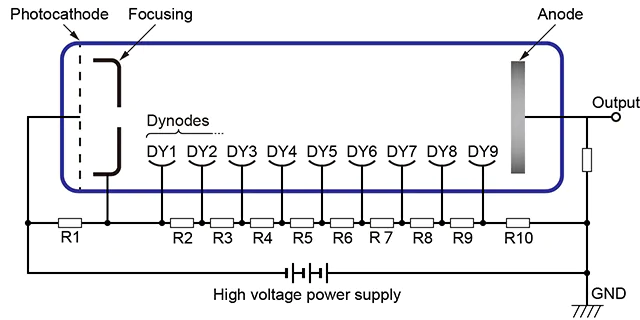
Photomultiplier tube circuit
- Photon counting
-
Photon counting is one of the applications of photomultiplier tubes to count the number of photons (light).
A window (input window or entry window) is the glass surface through which light enters the photomultiplier tube. Also called photocathode.
Read more
- CW Circuit
-
CW circuit is an abbreviation for Cockcroft-Walton circuit. The CW circuit is a high-voltage generator circuit consisting of a capacitor and diodes connected in a trussed configuration.
For more information, see the "High Voltage Power Supply" link.
Cockcroft-Walton circuit  Read more
Read more
- Stem
-
The stem is the bottom surface of the photomultiplier tube. The electrode pins (terminals) are also called stem pins. The photomultiplier tubes consisting of a glass bulb and a stem are referred to as stems.
- Photocathode (Cathode)
-
The photocathode (cathode) is the inner surface of the entry window of the photomultiplier tube.
A photocathode converts light (photons) into electrons through the photoelectric effect. Electrons emitted from the photocathode are pulled to the focusing electrode and amplified at the dynode. The photocathode material is an alkali metal, and there are bialkali photocathodes and multialkali photocathodes.
Read more
- Multiplier
-
Multiplier = Refer to Electron Multiplier (Dynode).
- Spectral response (Spectral sensitivity)
-
Spectral response is a sensitivity characteristic due to the wavelength of incident light. The spectral response differs depending on the photocathode.
- Head-on
-
A head-on is a type of photomultiplier tube shape with an entry window at the tip of the cylinder.
- Side-on
-
Side-on refers to a type of photomultiplier tube shape with an entry window on the side of the cylinder.
- Window (input window, entry window, )
-
A window (input window or entry window) is the glass surface through which light enters the photomultiplier tube.
Also called photocathode.
- Photoelectric effect
-
The photoelectric effect is the emission of electrons when light strikes a material.
See photocathode.
- Divider (Voltage division)
-
In a photomultiplier tube, there are multiple electrodes in the dynode section, each of which is supplied with a different voltage. The part of the circuit that divides the voltage to supply these different voltages is called the voltage divider.
- Magnetic Shield
-
Magnetic shielding is protection (shielding) against the effects of magnetic fields.
The inside of the photomultiplier tube is a vacuum, and electrons travel by flying between the electrodes. Electrons curve under the influence of magnetic fields. Magnetic shielding is required when using photomultiplier tubes in field work or in strong magnetic fields. The magnetic shielding prevents output errors caused by geomagnetism and magnetic fields.
Read more
- Lumen (unit of luminous flux)
-
Lumens are used as a unit (lm) to express the amount of brightness (luminous flux) of light generated by a light source.
Photomultiplier tubes use this lumen as the incident luminous flux to measure characteristic parameters. Generally, the unit for expressing the brightness of lighting is lux (lx). This unit represents radiant illuminance (illuminance) and is used to express the brightness of lighting fixtures.
Read more
- Gain
-
Gain is the amplification factor. Photomultiplier tubes have amplification factors ranging from 100,000 (5th power of 10) to 100,000,000 (8th power of 10).
- Linearity
-
Linearity refers to how closely the correlation between the amount of light incident on the photomultiplier tube and the output signal is linear (how little distortion is present).
- Hysteresis
-
Hysteresis is a state of poor linearity of sensitivity. In a photomultiplier tube with hysteresis, the output value differs between increasing and decreasing values for the same light input.
- Dark current
-
Dark current is the current that flows even in the absence of light incident on the photomultiplier tube. Dark currents are caused by the electron emission from photocathodes and dynodes, leakage currents between electrodes, and electric field emission.
- S/N ratio (signal-to-noise ratio)
-
S/N ratio is the ratio of signal (Signal) to noise (Noise). Noise also includes dark current.
- Time characteristic
-
Time characteristic is one of the indicators of photomultiplier tube characteristics. Photomultiplier tubes have very fast time characteristics. Time characteristics include rise time, fall time, pulse width, and electronic run time.
- Gate circuit
-
The gate circuit is the on/off circuit of the photomultiplier tube. Photomultiplier tubes are used to measure faint light, but if excessive light is incident on them, the circuit may saturate or otherwise adversely affect their characteristics. Therefore, a gate circuit is provided to turn off unnecessary outputs.
- Coupling capacitor
-
Coupling capacitors are used in the output signal circuit of photomultiplier tubes. This capacitor allows only the signal component to pass through and block the DC component.
- Decoupling Capacitor
-
The decoupling capacitor is part of the output signal circuit of the photomultiplier tube. This capacitor removes the noise component and allows the DC component to pass through.
- Housing
-
A housing is an enclosure, cover, or container. The photomultiplier tube housing serves the functions of shielding against extraneous light, fixing holes, magnetic shielding, and circuit packaging.
- Scintillator
-
A scintillator is a material that has the property of emitting light when exposed to radiation. Inorganic/organic and solid/liquid scintillators are available.
Inorganic scintillators such as alkali halide crystals such as NaI(Tl) and CsI(Tl) and oxide crystals such as BGO are used for radiation detection. Survey meters (radiation detectors) often use a combination of this scintillator and a photomultiplier tube.
Read more
- Pre-amplifier
-
A preamplifier is a circuit that converts the current output signal from the photomultiplier tube into a voltage signal and amplifies it.
- PHA
-
PHA is an abbreviation for Pulse Height Analyzer. This circuit analyzes the radiation energy received by a survey meter or other radiation detector.
The amount of light emitted by the scintillator changes according to the energy of the radiation, and the height of the output pulse of the photomultiplier tube is linked. Analyzing the height of the pulse with the PHA will tell you the energy of the radiation.
Read more
- Bialkali
-
Bialkali is a type of photocathode of a photomultiplier tube that is sensitive to visible light.
Bialkali is used in radiation detectors because its spectral sensitivity is around 400-420 nm, which is compatible with the emission wavelength of sodium iodide (NaI) scintillators at 415 nm.
Read more
- Protection circuit
-
A protection circuit is designed to protect a circuit in the event of an abnormality. As photomultiplier tubes use high voltage, the protection circuit is required to protect the readout circuit and other components against overvoltage and overcurrent.
Related Technical Article
Matsusada's collection of Photomultiplier tube (PMT) precise High Voltage modules!!
- Related words:
-
- electron microscope
- neutrino
- gamma detector
- CT scanner
- radiation
- Nox meter
- Sox meter
- fluorescence analysis
- reagent
- positioning PMT




